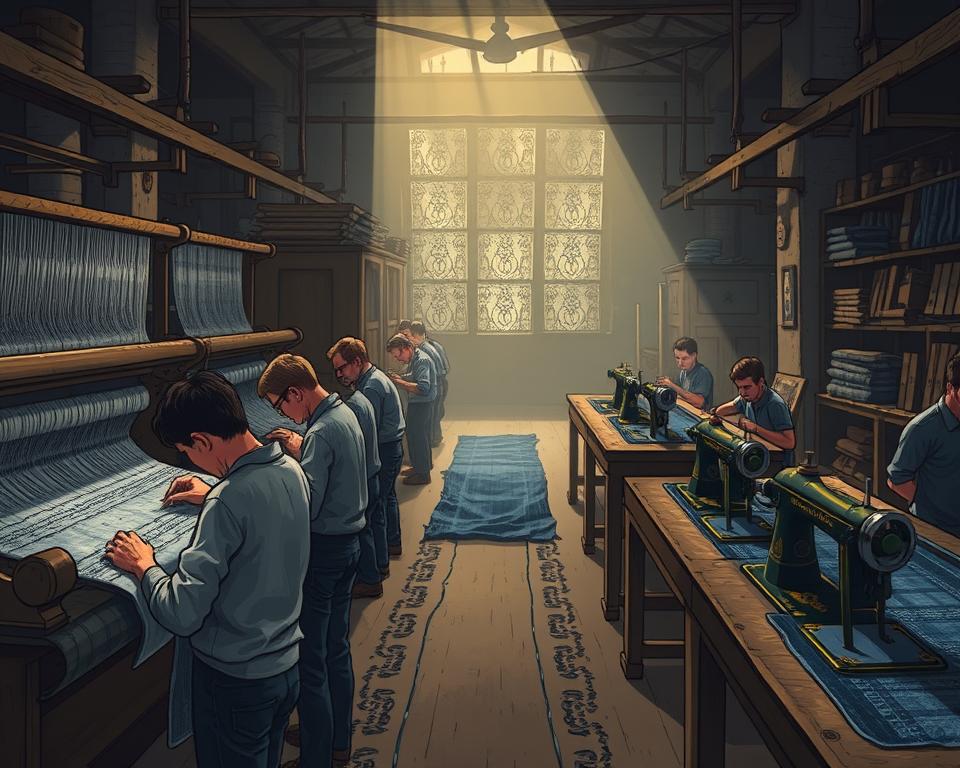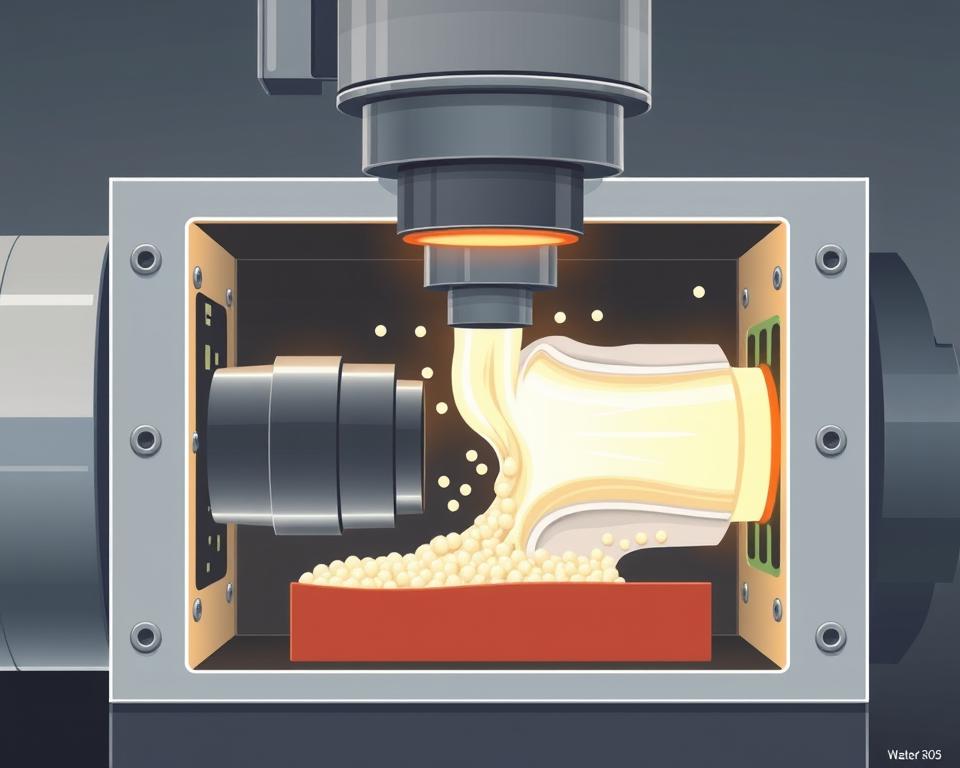The Complete Guide to Selvedge Denim Material
One solitary set of antique Levi’s 501s hailing from the 1940s fetched $87,400 at an auction. Why were these trousers valued higher than a high-end automobile? The answer lies in their selvedge denim material construction.
This premium denim represents more than just fabric. It connects us to a time when James Dean wore his 501s in Rebel Without a Cause and Marlon Brando defined cool in The Wild One. Those pop culture legends weren’t merely clad in denim. They sported selvedge denim fabric made on historic shuttle looms.
Handcrafted denim earns its moniker from the self-finished borders that stop fraying. “Selvedge” merges “self” with “edge” to denote this distinct weaving technique. Unlike mass-produced jeans, each yard of selvedge denim material takes time and skill to create.
The surface narrates a tale via gentle inconsistencies and organic variations. Each iteration gains personality as the indigo lightens. This individual progression renders heritage denim exceptional to collectors and style aficionados alike.
Numerous people assume high-end denim endures beyond ordinary jeans. The truth is more nuanced. Selvedge crafting produces lovely material with tidy edges and robust texture. However, sturdiness relies on cotton caliber and heft, not merely on weaving style. What sets artisanal denim apart is its ability to age gracefully and develop unique fade patterns over time.
What Is Selvedge Denim Material
Selvedge denim fabric is distinct from regular denim due to its unique construction and finished edges. It draws its name from the “self-edge,” a dense woven strip that stops fraying. This top-tier fabric embodies a commitment to slow fashion and classic artisanry, distinguishing it from factory-produced denim.

The Meaning Behind Self-Edge Construction
The word “selvedge” fuses “self” with “edge,” indicating material with a tidy, sealed edge. This narrow selvage runs along both sides, removing the requirement for added finishing. Old-school mills craft it at roughly 30–32 inches wide, unlike contemporary denim’s 60-inch span.
Why Shuttle Looms Yield Distinct Fabric Edges
Shuttle-loomed denim’s character comes from vintage weaving machines that weave at slower speeds. They shuttle one weft yarn across the warp threads in one continuous action. This process yields:
- Natural irregular slubs
- A softer hand-feel than modern denim
- Firmly locked edges that avoid fraying
- Real irregular traits loved by denim aficionados
Selvedge vs. Standard Denim
Standard denim is made on projectile looms that shoot weft yarns across wider fabric. This method leaves loose threads at the edges, needing overlocked seams to prevent fraying. Selvedge denim fabric, by contrast, demands more time to make. It delivers enhanced durability and a distinct look, warranting its premium price.
Origins and Evolution of Shuttle-Loomed Denim
Heritage denim’s story began in 19th-century American textile mills. Shuttle looms were central, weaving material with sealed edges to avoid fraying. That approach yielded indigo-dyed denim slowly and painstakingly, guaranteeing each yard was made with precision. The fabric’s limited width turned into a signature of craft denim making.
American Mills of the 1800s to Today’s Resurgence
For upwards of a century, American factories leaned on shuttle looms. Names such as Cone Mills and White Oak furnished top denim to workwear makers. By the 1970s, faster projectile looms took over, replacing most shuttle equipment. This shift was driven by the need for cheaper, mass-produced jeans. Numerous old mills shuttered or updated, letting antique looms sit idle.
How Japan Revived Selvedge Denim
In the 1980s, Japanese manufacturers revived American shuttle looms. The Osaka Five labels headed this resurgence:
- Studio D’Artisan
- Evisu
- Fullcount
- Warehouse
- Denime
These companies merged American vintage style with Japanese precision. They examined vintage Levi’s patterns and reimagined time-honored indigo-dyed denim feels. By 2000, Japan dominated the artisanal denim market globally.
Relevance of Classic Weaving Now
Shuttle looms create special fabric features unmatched by modern equipment. Their reduced-speed weaving enables uneven textures and richer indigo absorption. Premium denim enthusiasts cherish these imperfections as signs of authentic craftsmanship.
| Shuttle Loom Features | Modern Loom Features |
|---|---|
| 29-31 inch fabric width | 60+ inch fabric width |
| 3-4 yards per hour | 15-20 yards per hour |
| Natural irregularities | Uniform texture |
| Self-finished edges | Cut edges requiring overlocking |
Crafting Premium Denim with Vintage Looms
Premium denim production kicks off with the steady rhythm of antique shuttle looms. These devices vary greatly from today’s looms. They weave yarn across the fabric width in a single thread, locking the edges without finishing. This technique assures a crisp, fray-resistant edge on selvedge denim.
Old shuttle looms turn out a mere 5 to 6 meters of striped denim fabric each day. This is in stark contrast to modern machines, which can weave 200 meters. Slow operation enhances the yarn by:
- Lower tension in threads produces a plusher hand
- Natural irregularities remain intact for unique texture
- Uneven surfaces lead to distinctive fading patterns
- Slim widths (around 29–32 inches) cut down waste
Running these vintage looms demands expert operators. Operators fine-tune tension, track cadence, and carry out maintenance. Each loom has its own unique character. Some date back to the 1920s, needing specific knowledge passed down through generations. This hands-on approach makes shuttle-loomed denim a true artisan product.
The narrow width of dry denim from vintage looms has a practical benefit. Jean makers can use the self-finished edge as the outseam, eliminating waste. This flaunts the cloth’s true craftsmanship. Every bolt carries history, with slight quirks that mass output cannot match.
Understanding Raw Denim vs Selvedge Differences
Numerous denim lovers conflate raw denim with selvedge denim. This misunderstanding crops up while seeking high-end jeans. The fact is they denote separate facets of denim creation. Understanding this difference guides smarter choices and deeper appreciation of each style’s uniqueness.
Why Selvedge Doesn’t Always Mean Raw
Selvedge indicates the shuttle-loom weave that forms self-finished borders. Raw denim means unwashed fabric straight from the mill. A selvedge raw denim distributor often carries both rinse and dry options. Companies like Naked & Famous craft selvedge jeans, sometimes pre-washed or stretch-infused.
The weaving technique remains the same. Yet, the finishing process changes everything about the fabric’s feel and look.
Washed vs Unwashed Denim Options
Every denim piece begins as dry denim before washing. Weavers ship both standard and selvedge bolts unwashed. Key contrasts include:
- Raw denim evolves custom fade patterns via use
- Pre-washed denim offers instant comfort and stable sizing
- Sanforized raw stays closer to original measurements after first wash
- Unsanforized cloth contracts substantially when wet
Debunking Common Denim Misunderstandings
Not every raw denim is shuttle-loom produced. Contemporary projectile looms likewise churn out unwashed textile. Their appeal converges since consumers prize longevity, customization, and artistry in both selvedge and raw denim. Each style lures denim aficionados ready to devote time for bespoke fades.
Spotting Genuine Selvedge Denim Traits
When hunting for rainbow selvedge denim, identifying authentic selvedge denim is crucial. It separates you from everyday customers. Authentic selvedge denim features attributes absent in normal denim. Recognizing these markers certifies you’re purchasing genuine premium denim.
How to Spot the Selvedge ID
Easiest method to confirm selvedge denim? Inspect the outseam. Turn up the cuff and look at the seam along the outside of the leg. Genuine selvedge denim has a clean, finished edge with colored yarns woven into the fabric. This self-finished edge eliminates the need for overlocking stitches found on regular denim.
Rolling your cuffs unveils the selvedge ID, giving your outfit a signature detail. The tinted edge threads flow uninterrupted along the outseam, crafting that iconic denim aesthetic fans love. Non-selvedge jeans, on the other hand, have cut edges covered with serger stitching to prevent fraying.
Quality Construction Hallmarks
Top-tier premium denim reveals itself by key build features:
- Tight, even weaving with no loose threads
- Pristine selvedge ends with no added stitching
- Consistent colored yarn throughout the outseam
- Heavy fabric weight characteristic of shuttle looms
What Makes Rainbow Selvedge and Redline Special
Rainbow selvedge incorporates varied colored threads in the ID, yielding a vibrant multicolor border. Redline selvedge, the iconic type, employs red threads in the ID and hails from classic U.S. mills. These unique selvedge forms carry premium prices thanks to their scarcity and aesthetic allure. Brands often showcase these details in listings, aiding you in spotting genuine heritage denim.
Why Craft Denim Costs More
Newcomers are often astonished by artisanal denim price tags. Selvedge jeans often cost 3–5× more than factory-made pairs.
Grasping the reasons for these prices uncovers the real worth of high-end denim.
Shuttle looms weave at a much slower pace than modern machines. While industrial looms produce fabric quickly, vintage shuttle looms weave only 1-2 meters per hour. This slow process means a single roll of heritage denim takes days, not hours.
The narrow width of selvedge fabric adds to the cost. Whereas conventional denim comes 60 inches wide, shuttle-loomed premium denim measures only 28–32 inches. This restricted width entails meticulous layout and cutting to minimize waste.
Craft denim making happens in small runs. Mills like Okayama’s White Oak and Kuroki prioritize quality over quantity. They staff master artisans who manage each stage:
- Hand-checking yarn tension
- Adjusting loom settings for each fabric type
- Inspecting every meter for flaws
- Managing rope-dyeing processes that take weeks
These artisans treat denim-making like fine art. They play with distinct yarns and hone indigo-dye recipes handed down through the lineage. Backing heritage denim helps mills safeguard textile legacies and artisans devoted to their work.
Where to Buy Black Selvedge Denim Fabric Wholesale
The high-end denim scene has expanded past Japan’s classic mills. American brands now compete, providing a wide range of black selvedge denim fabric wholesale. To find the best supplier, it’s essential to understand quality markers and the origins of authentic materials.
Finding Quality Suppliers and Manufacturers
Quality suppliers emphasize heritage weaving and a deep passion for craftsmanship. When searching for a selvadge raw denim fabric wholesaler, look for mills that use vintage shuttle looms. These suppliers offer detailed fabric specs, including weight, weave pattern, and dye methods.
Key Gold Selvedge Denim Producers
Gold-ID selvedge producers spotlight rich edge threads, boosting denim opulence. Top factories craft these niche fabrics in small batches, drawing boutique labels. The gold-ID thread bestows an exclusive trim, differentiating them from usual choices.
How to Procure Nep Denim and Unique Weaves
Special weaves like nep denim warrant direct sourcing links. Nep denim boasts purposeful slubs for eye-catching texture. Partnering directly with mills guarantees availability of these niche weaves.
| Fabric Type | Minimum Order | Lead Time | Price Range per Yard |
|---|---|---|---|
| Black Selvedge | 500 yards | 6-8 weeks | $12-18 |
| Gold ID Selvedge | 300 yards | 8-10 weeks | $15-22 |
| Nep Denim | 400 yards | 10-12 weeks | $14-20 |
Popular Selvedge Styles and Fabric Variations
Selvedge denim’s realm extends past plain indigo. Today, mills create a wide range of textures and patterns. These demonstrate shuttle-loom weaving’s flexibility. Ranging from faint surface quirks to striking patterns, they deliver one-of-a-kind personality that evolves elegantly with use.
All About Slub Denim Texture
Slub denim’s distinctive bumpy texture comes from irregular yarns. These yarns have thick and thin spots, creating a fabric surface with natural variations. Woven on shuttle looms, they form slub-textured selvedge that fades unpredictably.
Every slub denim pair evolves a distinct fade motif. Thick slub raised zones age in contrast to smooth zones, giving each a unique look.
Herringbone Selvedge Traits
Herringbone selvedge denim fabric has a distinctive zigzag pattern, resembling fish bones. It yields slanted lines alternating direction at consistent spaces. This motif boosts aesthetics and reinforces the cloth’s durability.
Popular brands like Iron Heart and The Strike Gold regularly use this weave for their premium collections.
Understanding Striped Denim & Specialty Weaves
Striped denim uses alternating threads to form vertical or horizontal stripes. Mills achieve these patterns by alternating different colored threads during weaving. Some popular variations include:
- Hickory stripe with alternating indigo and white
- Railroad stripe featuring thin pinstripes
- Wabash stripe with printed dots over stripes
| Fabric Type | Visual Pattern | Fade Characteristics |
|---|---|---|
| Slub Denim | Bumpy, irregular surface | High contrast, uneven fading |
| Herringbone | Zigzag diagonal lines | Subtle vertical streaking |
| Striped Denim | Alternating color bands | Pattern remains visible after fading |
Caring for Your Heritage Denim Investment
Your heritage denim calls for tailored care to grow its special character. Raw and dry denim, unlike typical jeans, change shape with wear. They form custom fade stories unique to you.
Your first few wears in artisan denim might feel firm and odd. This is normal. The fabric needs time to soften and mold to your body shape. Some wearers hasten the softening by donning them in the shower or squatting when damp. Others opt for a gradual, more organic break-in.
Raw denim shows top fade patterns when you postpone laundering. Natural skin oils and daily movement produce whiskers at knees and honeycombs on the back. Many owners go six months before their first wash, while some wait a full year. This discipline grants you dramatic, bespoke fades reflecting your motions.
At wash time for dry denim, invert and launder in cold water. Skip the spin cycle and hang dry away from direct sunlight. Others opt for gentle hand-wash in a bathtub using a soft detergent. Steer clear of hot water and tumble drying, which may shrink and dull fades.
Your denim investment appreciates with correct maintenance. Each use builds character, turning your jeans into a singular piece. The firm break-in becomes a flexible second skin mirroring your daily life.
Where to Find Quality Indigo-Dyed Denim
Selvedge denim’s comeback has created fresh opportunities for fans. Major retailers now carry indigo-dyed denim alongside specialty stores focused on premium denim and slow fashion. This allows consumers to find authentic selvedge options at various price points, catering to different budgets and styles.
Levi’s offers their 501 Original Fit Selvedge Jeans for $148, making heritage craftsmanship accessible to a wider audience. Uniqlo carries Selvedge Straight Jeans for $50, drawing budget-conscious style seekers. For those looking for higher-end options, Buck Mason features Japanese Loom State Selvedge Full-Saddle Jeans at $248. Iron Heart pushes premium denim further with its 634s-18 Vintage Denim Jeans at $385 via Self Edge.
American names like Todd Snyder and Buck Mason have entered competition with Japanese maestros in the selvedge scene. They understand that heritage weaving and top quality drive slow fashion. Whether shopping online or in physical stores, quality indigo-dyed denim is more accessible than ever to American consumers who cherish authentic craftsmanship.


